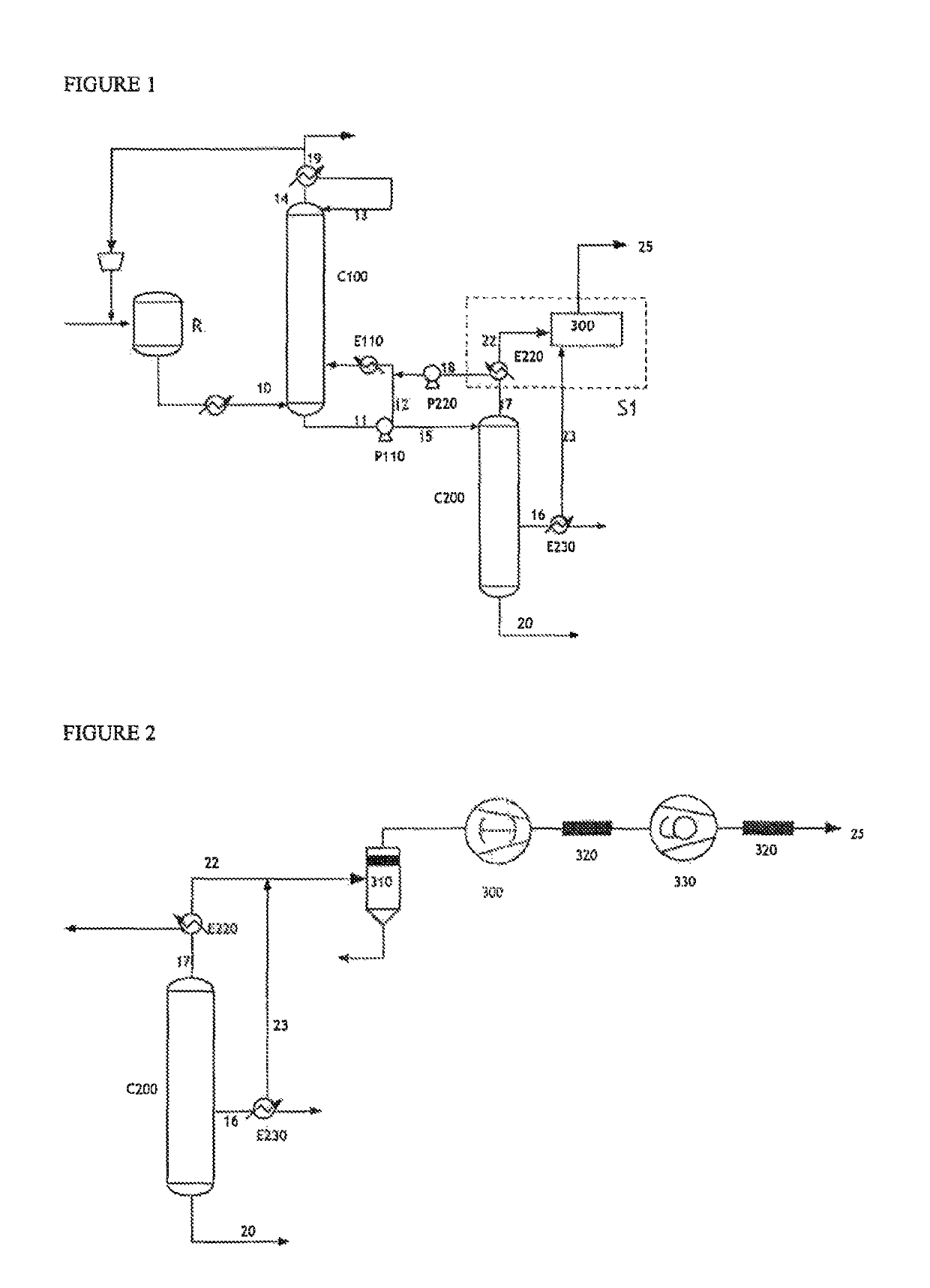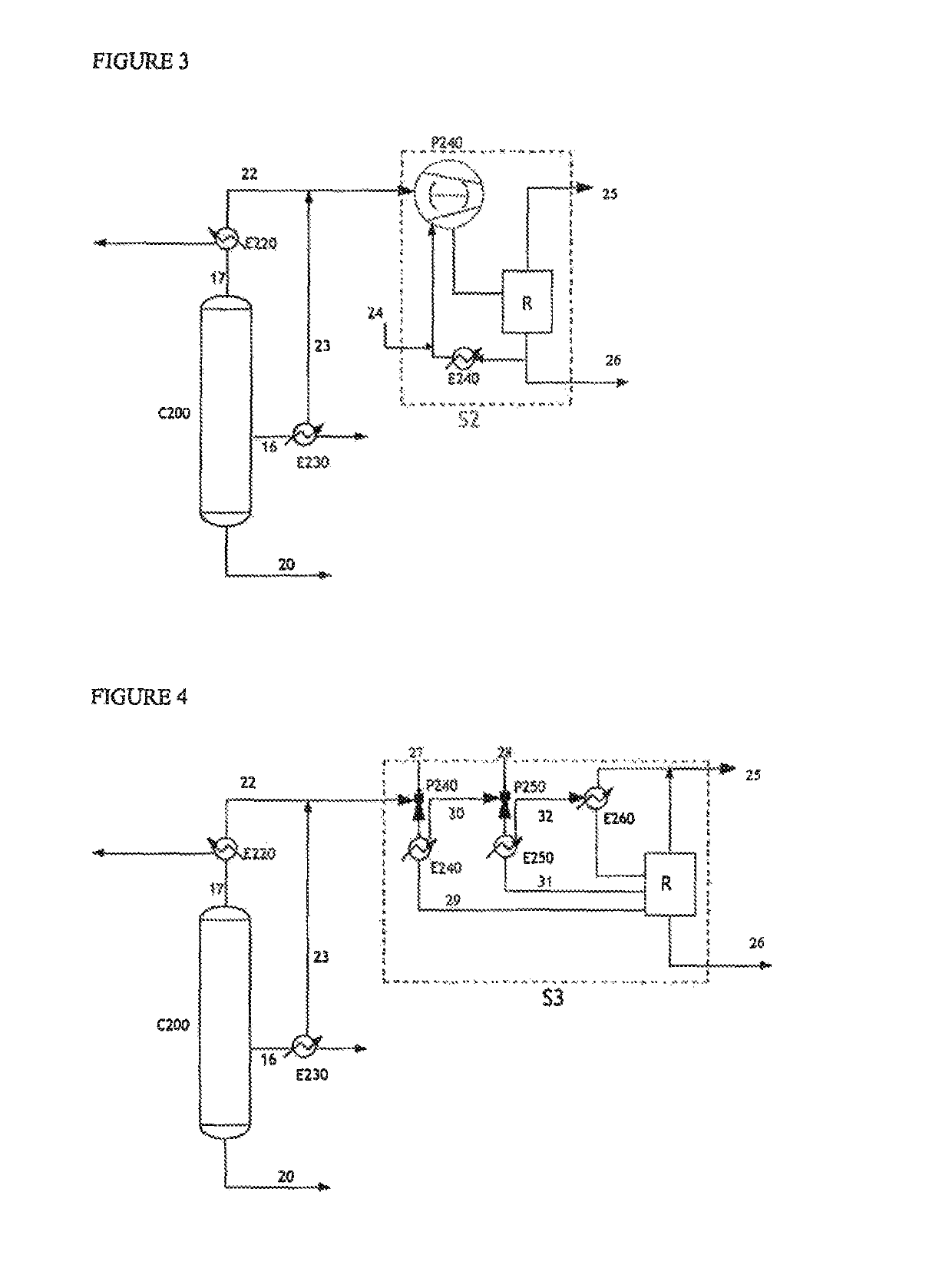Process for producing (meth)acrylic acid
a technology of acrylic acid and process, applied in the field of production of (meth)acrylic acid, can solve the problems of increasing the number of distillation columns and their associated energy costs, and increasing the cost of production
- Summary
- Abstract
- Description
- Claims
- Application Information
AI Technical Summary
Benefits of technology
Problems solved by technology
Method used
Image
Examples
example 1 (
According to the Invention)
[0135]Simulations using ASPEN software have been used to illustrate the process according to the invention.
[0136]With reference to FIG. 1, in a process for the continuous production of acrylic acid from propylene, a reaction mixture 10 was subjected to the recovery / purification process according to the invention.
[0137]In this process, 11 000 kg / h of technical acrylic acid are produced (stream 16), having a purity of 99.8%. The main impurities are acetic acid (0.05%), propionic acid (0.021%), furfural (0.014%), benzaldehyde (0.008%) and maleic anhydride (0.037%).
[0138]The gaseous stream 22 (67.6 kg / h) originating from the condenser E220 at the top of the finishing column C200 was subjected to a dry vacuum pump 300. This pump provides a pressure of 12 kPa at the top of the column C200. A stream 23 (7.3 kg / h) originating from the condenser E230 placed at the side outlet of the technical acrylic acid stream was sent at the same time to the dry vacuum pump 300....
examples 2 and 3 (comparative)
[0144]By way of comparison, the same streams 22 and 23 were subjected respectively to a liquid ring pump (Example 2, FIG. 3) as a replacement for the dry vacuum pump, and to a system incorporating steam ejectors (Example 3, FIG. 4).
[0145]In particular, Example 3 involves a steam ejector vacuum generator technology described in document U.S. Pat. No. 6,677,482 or 7,288,169.
[0146]Represented in FIG. 3 is a system S2 that incorporates a liquid ring pump P240, fed by a water stream 24. The flow rate of the stream 24 introduced into the pump in order to provide a pressure of 12 kPa is 1000 kg / h. This system S2 comprises a pump P240, an exchanger E240 and a receptacle for collecting the condensates R.
[0147]The pump P240 is fed on the one hand by the gaseous streams 22 and 23 originating from the column C200 and on the other hand by the aqueous stream 27. The main role of this aqueous stream is to constitute a liquid seal necessary for the generation of the vacuum in the pump and to ensure...
example 4
[0157]In order to avoid the expensive treatment of the aqueous stream resulting from the liquid ring pump (Example 2) or from the ejector system (Example 3), and to recover a portion of the acrylic acid contained in these streams, it may be envisaged to recycle these streams to the solvent-free purification process.
[0158]A simulation of the solvent-free purification process was carried out using ASPEN software, incorporating a recycling of the aqueous stream 26 condensed in Example 3 (ejectors in series), as a mixture with the stream 18 sent to the dehydration column C100 (see FIG. 1).
[0159]Under these conditions, contrary to the desired objective, it is observed that the recycling of this aqueous stream (1032 kg / h) gives rise to a significant loss of acrylic acid at the top of the condensation column C100.
[0160]The loss of acrylic acid in the stream 19 cooled to 61° C. is 1.74%, i.e. an acrylic acid recovery yield of 98.26%.
PUM
| Property | Measurement | Unit |
|---|---|---|
| weight ratio | aaaaa | aaaaa |
| weight ratio | aaaaa | aaaaa |
| pressure | aaaaa | aaaaa |
Abstract
Description
Claims
Application Information
 Login to View More
Login to View More - R&D
- Intellectual Property
- Life Sciences
- Materials
- Tech Scout
- Unparalleled Data Quality
- Higher Quality Content
- 60% Fewer Hallucinations
Browse by: Latest US Patents, China's latest patents, Technical Efficacy Thesaurus, Application Domain, Technology Topic, Popular Technical Reports.
© 2025 PatSnap. All rights reserved.Legal|Privacy policy|Modern Slavery Act Transparency Statement|Sitemap|About US| Contact US: help@patsnap.com


